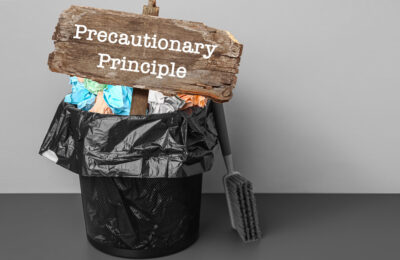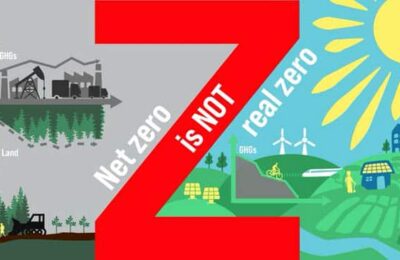From The Ecologist
The ‘get out of jail free card’ was the board game Monopoly’s gift to the English language, and it is how big polluters seem to view carbon offsetting.
But offsetting is a claimed solution to the pollution pushing global heating that can actually make the problem worse.
Perhaps that should come as no surprise, as the irony is matched by Monopoly itself, a game invented by Quakers to teach the evils of rentier capitalism that became a celebration of rampant property and wealth accumulation.
Competition
The Men’s FIFA World Cup in Qatar was promoted as the first “fully carbon neutral FIFA World Cup tournament”. This claim, made before the tournament had even begun, depended on questionable carbon accounting tricks and extensive use of offsetting.
Yet both have been called-out for lacking scientific credibility, transparency, and integrity. Rising awareness of the climate emergency means many in the world of sport – clubs, events, and fans – and far beyond, are turning to offsetting as a well-intentioned, or just convenient way to compensate for the impact of their carbon emissions.
But, it wasn’t even as if FIFA or Qatar were promising to do the offsetting themselves, partly they just provided fans and players with ideas on how to cut their carbon footprint in their everyday lives.
Travelling fans were also invited to voluntarily offset their flight emissions, even though few typically do and flight offset schemes known to be deeply flawed.
But even direct efforts by FIFA were little better. The competition claimed to offset emissions by purchasing carbon credits through a non-standard carbon market initiative set up specifically for the Qatar World Cup, the Global Carbon Council.
Smoking
This claims it will support renewable energy projects in the region that displace fossil fuel generation, but for many of these projects it highly likely that they’d have been built anyway, meaning that the purchasing of carbon credits does little to reduce overall emissions.
A tree and turf nursery were also set up in the desert to capture carbon, produce trees for stadium exteriors, and grass for the pitches and training grounds.
But tree plantations used for offsetting have already been shown to burn down during forest fires, in heatwaves set to be more common and intense in a warming world.
In this smouldering cloud, a ‘fossil fuels’ for trees swap is exchanging stable, reliable carbon storage for something that can easily go up in smoke – it’s basically a kind of carbon laundering.
Offsetting is a bit like trying to give up smoking by paying someone else to bake a cake. It fails to compare like for like.
Offsetting is a bit like trying to give up smoking by paying someone else to bake a cake. It fails to compare like for like.
Procurement
Using stable stores of fossil carbon from the geosphere will not be ‘cancelled out’ by planting a tree that may, or may not grow, whose lifespan is uncertain, and could fall victim to drought, flood, or blight.
Baking a cake may be a good thing to do in itself, but it’s unlikely to help you quit cigarettes. Similarly, planting a tree will not make up for the real, long-lived impacts of carbon emissions released into a saturated atmosphere now.
The problem is that offsetting in its current form simply does not do what the name implies. Due to a mix of scientific and practical problems, offsetting often doesn’t work at all, and can even make the problem worse.
The theory goes that through offsets, organisations, events or individuals, effectively ‘erase’ or ‘cancel out’ the emissions that arise from their on-going activities, whether it’s from transport, constructing stadiums, or powering facilities.
Following this logic, organisations can purchase additional offsets to reduce their ‘overall’ impact, thereby making it possible to claim absolute reductions in their emissions and environmental impact when, in reality, they have made no adjustments to their habits, behaviour, operations, procurement process, or organisational structures.
Pillar
This theory, however, quickly collapses in the face of the climate crisis.
Under the latest climate models produced by the Intergovernmental Panel on Climate Change (IPCC), limiting global heating to 1.5°C requires global emissions to peak before 2025 and be cut by 43 per cent by 2030, reaching net-zero in the early 2050s.
According to the IPCC, to achieve these temperature goals, global emissions need to fall by around 90 per cent, while various types of carbon removal will be relied upon to deliver just the other 10 per cent of required reductions.
On a basic level, relying on carbon offsetting instead of pursuing emissions cuts at source is simply out of touch with the science. But, it runs into big problems on several other levels too.
Offsetting has become a central pillar of corporate sustainability strategies, net-zero pledges, and national governments’ climate policy programmes too.
Wildlife
Household names like EasyJet, Heathrow Airport, BP, and Shell all heavily rely on offsetting schemes to ‘cancel out’ their operational emissions, appear as environmentally friendly, and claim carbon neutrality.
Implicitly they are heavily relied on in national climate plans, and used patchily by consumers to assuage consciences guilty, for example, at taking long haul flights.
Carbon offsets are big business and the global market is set to balloon in size as an ever-increasing number of organisations seek to claim carbon neutrality.
According to analysts, the demand for carbon offsets will increase by a factor of 15 or more by 2030 and by a factor of up to 100 by 2050.
By 2050, the global carbon market could increase to a value of $200 billion. There are concerns that demand for offsets will outstrip supply by as early as 2024, with new monoculture forestries putting immense pressures on land, communities, and wildlife.
Popular
Also, through offsetting projects and common, but controversial, emissions bookkeeping methods, known as ‘market-based accounting’, organisations can claim vast reductions in planet-warming emissions without transforming their operations, partnerships, or governance.
To illustrate this point, look no further than Cisco Systems, one of the largest tech conglomerates in the world that employs nearly 80,000 people.
In 2021, Cisco claimed triumphantly that they had cut their pollution across scope 1 & 2 (those emissions that are ‘owned’ or ‘controlled’ by the company) by 60 per cent over the past 15 years.
But when these claims were assessed through a different accounting method, which excluded the offset and renewable credits purchased by Cisco, the picture is entirely different: emissions climbed by 22 per cent.
A number of offsetting mechanisms are popular and set to dominate the global carbon offsetting market in the years ahead.
Divert
These include nature-based offsets – a category that uses plants, trees, forests, soil, or the ocean to remove carbon from the atmosphere and store it.
Depending on the offset project in question, this approach can, in theory, also protect and conserve ecosystems that are considered carbon sinks, such as rainforests and peat bogs, and embrace rewilding schemes. In 2019, nature-based offsets made up over half (56.4 per cent) of the voluntary offset market.
Then there are renewable energy offsets that seek to maintain or increase renewable energy generation, ultimately displacing fossil fuel use and therefore preventing carbon emissions being emitted in the first place. In 2019, renewable energy projects made up 21.3% of voluntary offset markets.
Cash is being made – but huge questions remain over their credibility, transparency and integrity.
Even some of the more traditionally cautious organisations are sceptical about the role of offsets. The International Energy Agency (IEA) stated in 2021 that, “there is likely to be a limited supply of emissions credits consistent with net-zero emissions globally and the use of such credits could divert investment from options that enable direct emissions reductions.”
Six ways that offsetting leaves us locked in climate jail
- Offsetting doesn’t work
In its current form scientific evidence suggests that offsetting doesn’t deliver on its promises. One study for the EU Commission found that 85% of the offset projects under the UN’s Clean Development Mechanism (CDM) failed to actually reduce emissions, and that only 2% of had a high likelihood of doing so. Some big corporate offsetting schemes have been ravaged by the very climate impacts they are meant to push back. In 2021, as record-breaking wildfires engulfed California, Oregon, and Washington in the USA, forest offsets bought by Microsoft and fossil fuel major BP were destroyed These occurrences are not rare. Since 2015, wildfires in California have damaged six forest offset buffer projects, releasing between 5.7 million and 6.8 million tonnes of carbon back into the atmosphere, according to CarbonPlan.
- Schemes can cause real harm
Offset projects can be harmful both in terms of direct failure, and also due to the impact of projects on local communities, economies, and the natural world. There are multiple examples of nature-based offsetting schemes being implemented without regard to the legal or customary land use rights of local people. These poor quality and shoddily implemented offset schemes have been shown to lead to human rights abuses, adverse effects on biodiversity and are less likely to provide long-term stores of carbon emissions. One common example is when native forests brimming with biodiversity are cut down to make way for fast-growing eucalyptus plantations, creating monocultures, devoid of wildlife, that can pull groundwater away from local communities and disrupt agriculture.
- Offsetting is a form of carbon laundering
Attempting to offset the burning of stable stores of fossil carbon by planting unstable stores like trees, that face multiple threats in our warming world, is not swapping like-for-like. Scientists believe that it will take close to half a million years for a tonne of CO2 emissions released today through the burning of fossil fuels to be removed from the atmosphere naturally. This hard scientific truth runs right to the heart of the offsetting predicament: to effectively undo emissions, offsetting mechanisms must remain in place for hundreds of thousands of years. The average contract for a tree planting offset scheme, however, is around 40 years.
- The system can be gamed
Through accounting tricks and murky carbon markets, offsets can be misallocated on a mass scale, which often means there is no reduction in overall emissions. It is very difficult to prove that renewable projects would not have been built anyway. Research from Berkeley, Oxford, and Carbon Plan found that up to 85 per cent of offsets sold today are not additional, which means the sale of these credits has no impact on reducing emissions.
- It provides an excuse for ‘pollution as usual’
Offsetting can justify and legitimise the status quo, allowing organisations to continue polluting while claiming leadership and progress on sustainable and environmental issues. Relying on offsets allowed one company, mentioned above, Cisco systems, to claim a 60% cut in emissions, when their actual emissions had risen 22%. By analysing the carbon credits allocated to 1,350 wind farms across India, researchers found that at least 52% of approved carbon credits were allocated to projects that would have been built anyway. The researchers concluded that “in addition to wasting scarce resources, we estimate that the sale of these offsets to regulate polluters has substantially increased global carbon dioxide emissions.”
- Offsets inhibits real change
The cost and apparent convenience of offsetting means that the more challenging structural decisions required to address an organisation’s climate impact may be delayed. As an approach, offsetting is the flawed, temporary fix that by default becomes the main response to the problem. Especially where the wealthy are concerned, whether nations, corporations or individuals, if you can buy your way out of actually changing behaviour, why change at all? Thinking they are a realistic option for more systemic change, when they aren’t, restricts our thinking, creativity and ambition to find genuine ways to thrive in a bounded biosphere.
Get out of jail?
It’s clear that offsets cannot break the carbon pollution bonds currently locking humanity and the rest of the natural world into the brutal upheaval of a warming world.
In the race to decarbonise the global economy, if there is to be place for offsets, however small, they need to live up to certain basic criteria.
The means to escape the jail of global heating every offset project must be:
1. A genuine addition to other efforts to reduce emissions – as in, the carbon saving would not have happened without the scheme.
2. Permanent – carbon must be stored on a permanent basis to have ‘offset’ status – not, for example in an ecosystem that, due to warming, could flip from being a store to source.
3. Supported by local people – far too many projects disrupt and damage surrounding communities, so ensuring and maintaining local support is key.
4. Used only for residual emissions as a last resort: offsets must not be used to allow organisations to continue business-as-usual without transforming their internal operations, or individuals there behaviours.
These Authors
Andrew Simms is co-director of the New Weather Institute, coordinator of the Rapid Transition Alliance, an author on new and green economics, and co-author of the original Green New Deal. Follow on: t. @AndrewSimms_uk m. @andrewsimms@indieweb.social
Freddie Daley is a researcher at the University of Sussex, and works with Cool Down – the sport for climate action network, a network of sports organisations calling for climate action in and through sport,




